The Eternal Mystery of Stonehenge
by Pearl Harris
Situated in the chalky lands of Wiltshire county in southwest
England, nine miles north of Salisbury and just five minutes'
drive from the picturesque little town of Amesbury, Stonehenge
should be seen at least once by every visitor to Britain.
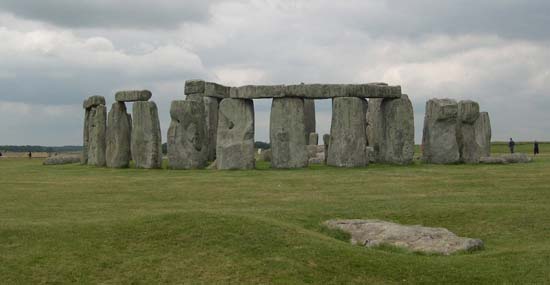
Apart from being the nearest town to Stonehenge, Amesbury has
a proud history of its own. Formerly known as Amblesberie,
Ambresbury and Ambrosbury, this pretty country town with a
population of 28,000 is situated nine miles west of
Salisbury.
Just west of Amesbury on the A303 bypass, clumps of beech trees,
known as the Trafalgar Clumps, were planted about 200 years ago
to represent the alignment of the English and French ships at the
Battle of the Nile. It is reputed to have been Lady Emma
Hamilton, Lord Nelson's mistress, who arranged for them to be
planted on the estate of the Duke of Queensberry. The latter,
himself an honorary Admiral, had befriended her after Nelson's
death at Trafalgar.
West Amesbury, previously known as "Little
Amesbury," is separated from the center of Amesbury by the
river Avon and an Iron Age fort. West Amesbury is worth a visit
for its thatched and timbered cottages and lovely period
dwellings. 17th Century West Amesbury House is thought to have
been associated with the Priory of Amesbury.
Through the ages, Amesbury has been a resting place for all
travelers on foot, horseback and stage coach. Today it is the
resting place of travelers of another kind, all with one single
purpose -- a glimpse of Stonehenge.
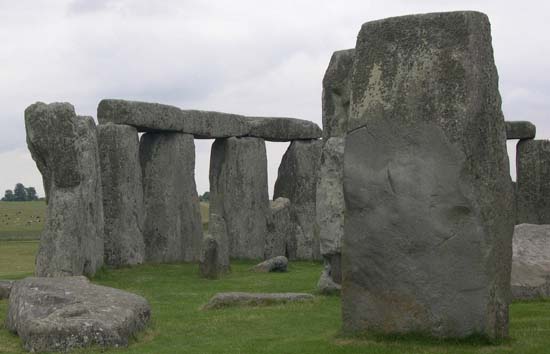
It is thought that the name "Stonehenge" derives
from the Anglo-Saxon "henge," meaning
"hanging." Thus "Stonehenge" literally means
"hanging stones," descriptive of the lintels suspended
above the massive stone pillars of this mystifying monument.
Stonehenge is the world's only stone circle to contain these
horizontal lintels. Today, the word "henge" has the
archeological definition of "a circular enclosure
surrounding settings of stones and timber uprights, or
pits."
My first visit to Stonehenge was in 1978. Having overnighted in
Amesbury, I walked along a quiet road across the green fields of
Salisbury Plain surrounded only by the sounds of the countryside.
Quite suddenly, as I came over a rise, the gigantic monoliths
appeared seemingly out of nowhere in the early morning
sunrise.
Virtually alone, I was free to wander around the mysterious stone
circle, to touch and breathe in its magical aura. No tour buses,
no motor cars, and very few other human beings were in sight.
This is the memory of Stonehenge I will always treasure. It
sounds almost unbelievable in the 21st century, doesn't it?
Sadly, modern tourism has left its indelible mark. Revisiting
Stonehenge in 2004, I was staggered at the sheer volume of
tourists, tour buses and motor vehicles of every description
swarming over the site. A fee is charged for the large adjacent
car park (refundable if you produce your entrance ticket to
Stonehenge).
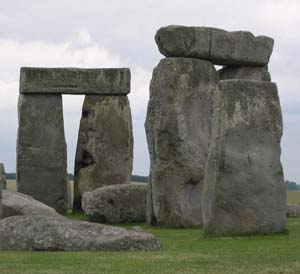 Cars whiz by at speed on the now busy main road along
which I had previously ambled and which is now only safely
crossed by means of an underground tunnel from the car park.
Once over the road and within the perimeter of the unattractive
high wire fence surrounding the monument, with an audio headpiece
in place, you traipse around the silent circle of inaccessible
monoliths in an endless queue of visitors, listening to a
commentary in your language of choice. Cars whiz by at speed on the now busy main road along
which I had previously ambled and which is now only safely
crossed by means of an underground tunnel from the car park.
Once over the road and within the perimeter of the unattractive
high wire fence surrounding the monument, with an audio headpiece
in place, you traipse around the silent circle of inaccessible
monoliths in an endless queue of visitors, listening to a
commentary in your language of choice.
Countless theories about the origin of Stonehenge have been
propounded through the ages. One of these is that it was a means
of astronomical calculation. Others theorize that it was a place
of sacrifice, sun-worship or the site of a royal palace. The
symmetry of the site and its location on a slight rise in the
otherwise flat valley provides views of the horizon all around.
Its alignment with sunrise and sunset points on summer and winter
Solstices gives credence to the view that it might have been an
ancient time-measuring site or observatory.
Stonehenge is classified as one of UNESCO's World Heritage Sites
which organization is attempting to solve the problem of the
public's dissatisfaction at the present protected arrangement for
viewing the site, while at the same time conserving it for
posterity.
The stone circle one sees now is only a very small part of the
original. Many of the outer stones were taken by local builders
and farmers for construction. Visitors through the ages have also
added to the gradual destruction of this monument, resulting in
the present day "look but don't touch" policy, which
angers and upsets many people.
The construction of Stonehenge is estimated to have taken place
in three stages. The outer circle is believed to have been of
wooden posts, surrounded by a ditch and bank. Fifty-six holes,
assumed to have held wooden posts, are situated around the edge
of the bank. These are known as "Aubrey Holes" after
John Aubrey, who discovered them in 1666.
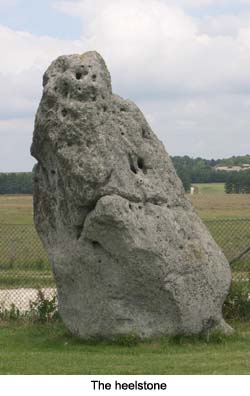 The ditch must have been dug by hand, with the aid of
animal bones. Deer antlers (discovered in excavations of the
ditch) were used as axes and the shoulder blades of oxen as
shovels. It was by carbon-dating of these antlers that scientists
learned that the first henge was built in approximately 3100 BC.
At this stage, too, the huge Heel Stone was placed at the
entrance of the central enclosure. The ditch must have been dug by hand, with the aid of
animal bones. Deer antlers (discovered in excavations of the
ditch) were used as axes and the shoulder blades of oxen as
shovels. It was by carbon-dating of these antlers that scientists
learned that the first henge was built in approximately 3100 BC.
At this stage, too, the huge Heel Stone was placed at the
entrance of the central enclosure.
In about 2500 BC the first stone circle was erected within the
earthworks. This circle consisted of approximately 80 massive
blocks of bluestones (dolerite), the origin of which is traced to
the Preselli Mountains in Pembroke, South Wales, 245 miles away.
One theory is that these blocks could have been carried to
Salisbury Plain by a glacier from the Welsh mountains in the last
Ice Age. However, the lack of other glacial debris in the area
seems to discount this theory, leaving us to believe that these
stones from the quarries of Preselli were somehow transported
here by man. They might conceivably have been dragged to the sea,
floated on massive rafts and then on up the River Avon and
finally hauled overland to Salisbury Plain. Considering the fact
that some stones are 25 feet in height and weigh approximately 40
tons, this is an incredible feat.
Work apparenlty ceased on Stonehenge for a period before the
completion of the second phase. In approximately 1500 BC this was
followed by the third phase, when the dolerite columns were
re-arranged.
Giant sandstones -- now knows as Sarsens -- were transported from
Marlborough Downs, 20 miles distant, to form a circle of 25
trilithons (two upright pillars crossed by a horizontal lintel)
and an inner horseshoe formation consisting of five trilithons.
By the use of stone balls known as "mauls," the
sandstones were hammered to size. Each pair of sarsen stones was
pulled upright and connected at the top by a lintel. Woodworking
techniques were used here for the first time, to enable the
lintels to remain in position. Joints were made in stone to link
the lintels in a circular fashion by means of tongue and groove
joints. The lintel and uprights were connected with ball and
socket joints or mortice and tenon.
Stonehenge was once the property of Sir Cecil Chubb, a local man,
who donated it to the nation in 1918. It is now managed and
preserved by the English Heritage and was declared a World
Heritage Site in 1986. The National Trust owns 1500 acres of
landscape around Stonehenge and is primarily concerned with the
protection of this land for future generations, the area being
rich in rare vegetation such as sedge grass and lichens.

Long before the construction of Stonehenge, Salisbury
Plain was covered in forests and later transformed to open
chalk downland. Today, the Plain is chiefly owned by the Ministry
of Defense, which through its ownership has fortunately saved the
100,000 acres from modern agricultural exploitation.
Now virtually uninhabited except by Army families living in
temporary barracks, Salisbury Plain was once the dwelling place
of Stone Age, Bronze Age and Iron Age man, with hundreds of
burial mounds scattered throughout the Plain testifying to this
fact.
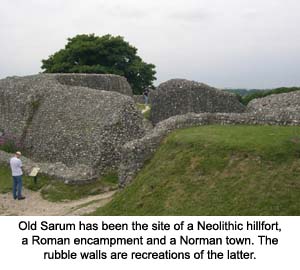 Apart from
Stonehenge, major historical sites are to be found at Old Sarum,
Figsbury, Danebury, Badbury and in the Marlborough region. Apart from
Stonehenge, major historical sites are to be found at Old Sarum,
Figsbury, Danebury, Badbury and in the Marlborough region.
The grave of "The Amesbury Archer," a male skeleton
dating back to approximately 2300 BC and also known as "The
King of Stonehenge," was unearthed three miles from
Stonehenge by the Wessex Archeological team in May 2002. This
grave was discovered during routine excavations and is one of the
richest of the early Bronze Age burial sites ever to have been
found. The goods buried next to the skeleton suggest he was a
warrior or possibly even a King.
The grave contained the earliest datable copper and gold
artifacts ever discovered in Britain. Oxygen isotope analysis of
the archer's teeth and bones suggests that he originated from
central Europe, probably the Alps. The significance of this find
is that in the Amesbury Archer, we have the first evidence that
people migrated from the continent of Europe to Britain over 4000
years ago. A second skeleton -- that of a younger man thought to
be a relative -- was later unearthed in the vicinity of the
Amesbury Archer.
More than a hundred artifacts discovered next to the Amesbury
Archer are on display in the Salisbury and South Wiltshire
Museum, and will be joined later by the human remains. These
artifacts include copper knives, flint arrowheads, pottery,
wristguards and gold hair ornaments. The Salisbury and South
Wiltshire Museum is situated in King's House, The Close, in
Salisbury. Its open hours are from Monday-Saturday 1000-1700
(July and August) and Sundays 1400-1700.
Just two miles northeast of Stonehenge, Woodhenge,
another henge monument, dates back to approximately 2300 BC. It
is thought to have consisted of six concentric rings of wooden
posts, probably covered by a roof or joined by lintels. A grave
of a young child has been found at Woodhenge, suggesting a ritual
sacrifice.
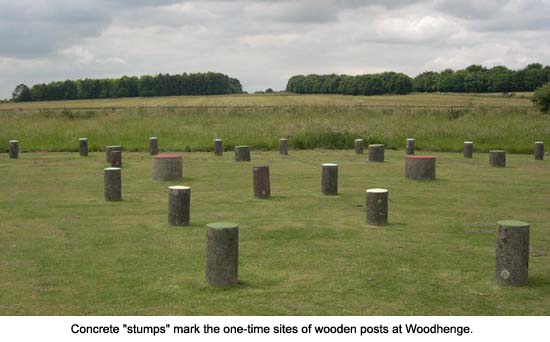
To the north of Stonehenge is the Cursus -- thus named
in the 18th century when it was thought to have been some kind of
racetrack. Other theories are that it had a ritual use, although
its true function has not yet been established. The Cursus
consists of two straight banks and ditches, (90-130 meters apart)
about two miles in length running from east to west.
Stonehenge and its surroundings will continue to inspire
controversy and debate for centuries to come. On the Modern
Antiquarian website, for example, we learn that in New Zealand,
the Phoenix Astronomical Society has, in February 2005, unveiled
a Stonehenge Replica near Wairarapa. Called Stonehenge Aotearoa,
this site is a full-scale replica and aims to assist in the study
of basic Astronomy.
Modern man may continue in his search for the truth of
Stonehenge, its original purpose and method of construction --
but will never fully uncover its secret. Herein lies the true
mystique that daily attracts such a multitude of visitors from
all over the globe to Salisbury Plain.
Related Articles:
- Stonehenge: The Giants' Dance, by Sue Kendrick
- https://www.timetravel-britain.com/articles/stones/stonehenge1.shtml
- Amesbury: A Stepping Stone to History, by Pearl Harris
- https://www.timetravel-britain.com/articles/towns/amesbury.shtml
More Information:
We regret that we no longer have the resources to maintain up-to-date links and/or hours and pricing details for the various sites and attractions listed on this website. For more information about the location(s) listed above, please use your favorite search engine or visit Wikipedia.
Pearl Harris, whose ancestors hail from Britain, was born in South Africa. In 2002, she emigrated to the Czech Republic with her husband, their dog and cat. Pearl resides permanently in the Czech Republic where she works as a freelance travel writer, English teacher and proof-reader. Her main passion is travel. Having traveled extensively in Africa, Europe,the USA and UK, she never intends to stop. Other interests are pets, photography, reading and writing. Pearl, a retired Diagnostic Radiographer, has a B.A. in English and Linguistics, post-graduate Diploma in Translation and TEFL qualification. Her only daughter, a professional photographer, lives in New Orleans.
Article © 2006 Pearl Harris
Photos © 2006 Moira Allen
| 